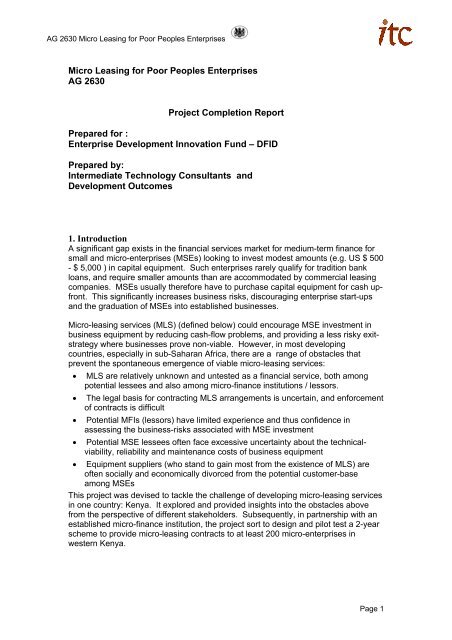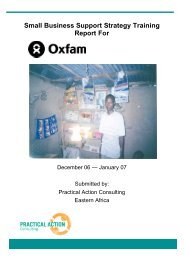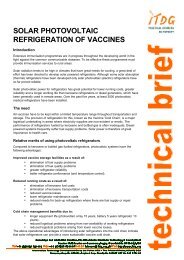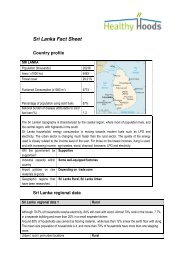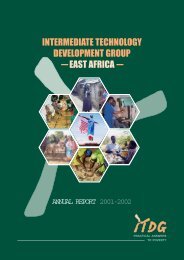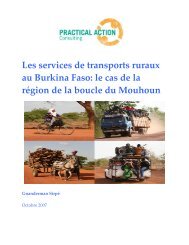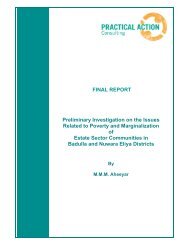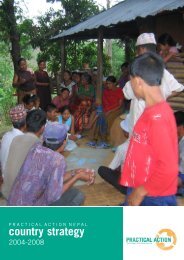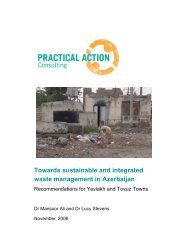Project Completion Report - Practical Action
Project Completion Report - Practical Action
Project Completion Report - Practical Action
You also want an ePaper? Increase the reach of your titles
YUMPU automatically turns print PDFs into web optimized ePapers that Google loves.
AG 2630 Micro Leasing for Poor Peoples EnterprisesMicro Leasing for Poor Peoples EnterprisesAG 2630<strong>Project</strong> <strong>Completion</strong> <strong>Report</strong>Prepared for :Enterprise Development Innovation Fund – DFIDPrepared by:Intermediate Technology Consultants andDevelopment Outcomes1. IntroductionA significant gap exists in the financial services market for medium-term finance forsmall and micro-enterprises (MSEs) looking to invest modest amounts (e.g. US $ 500- $ 5,000 ) in capital equipment. Such enterprises rarely qualify for tradition bankloans, and require smaller amounts than are accommodated by commercial leasingcompanies. MSEs usually therefore have to purchase capital equipment for cash upfront.This significantly increases business risks, discouraging enterprise start-upsand the graduation of MSEs into established businesses.Micro-leasing services (MLS) (defined below) could encourage MSE investment inbusiness equipment by reducing cash-flow problems, and providing a less risky exitstrategywhere businesses prove non-viable. However, in most developingcountries, especially in sub-Saharan Africa, there are a range of obstacles thatprevent the spontaneous emergence of viable micro-leasing services:• MLS are relatively unknown and untested as a financial service, both amongpotential lessees and also among micro-finance institutions / lessors.• The legal basis for contracting MLS arrangements is uncertain, and enforcementof contracts is difficult• Potential MFIs (lessors) have limited experience and thus confidence inassessing the business-risks associated with MSE investment• Potential MSE lessees often face excessive uncertainty about the technicalviability,reliability and maintenance costs of business equipment• Equipment suppliers (who stand to gain most from the existence of MLS) areoften socially and economically divorced from the potential customer-baseamong MSEsThis project was devised to tackle the challenge of developing micro-leasing servicesin one country: Kenya. It explored and provided insights into the obstacles abovefrom the perspective of different stakeholders. Subsequently, in partnership with anestablished micro-finance institution, the project sort to design and pilot test a 2-yearscheme to provide micro-leasing contracts to at least 200 micro-enterprises inwestern Kenya.Page 1
AG 2630 Micro Leasing for Poor Peoples EnterprisesHow these objectives relate to development work already undertaken in KenyaITDG has worked with small-scale producers in Africa (including Kenya for 15 years)and has recognised expertise in the management of technology choice for smallscaleenterprises 1 . Two studies 2,3 examined both the demand for businessequipment, and MFIs interest in extending their financial services to a wider clienteleof MSEs in Kenya.Context of the projectLeasing is an arrangement allowing businesses (lessees) to use an asset that isowned by a leasing company (lessor) in return for periodic payments. Unlike hirepurchase,leasing is characterised by clear separation of legal ownership from theeconomic use of the asset. This has advantages for both lessor and lessee: reducingthe cash required up-front for business start-up or expansion; providing a simplemechanism for loan-security, and permitting flexibility in the contractualarrangements rarely seen in the traditional banking sector. As a result, in the pasttwo decades, leasing has grown hugely as a source of financing for capitalequipment. 4Leasing has particular developmental benefits where lessees are predominantlysmaller enterprises seeking to make medium-term investments in businessequipment and tooling. Operating-leases, in particular, can provide MSEs with alower risk way to test business ideas, and thus increase business opportunities formore risk-averse entrepreneurs in poorer communities, especially women. For socialreasons, women are more likely to be able to take on leases than to make purchasesin cash.The growth in leasing described above has however essentially excluded the poorestcountries and enterprises at the lower-end of the size spectrum. (Lower limits oncommercial leasing contracts are typically around US $10,000 5 ). Leasingcompanies have thus far largely ignored or avoided the market for leasing amongmicro-enterprises – partly because the potential in this market segment has neverbeen tested, and partly because of the particular challenges they face in dealingeffectively with clients who require only modest credit-lines, and lack theparaphernalia of formal registration, accounts and officially-recognised businesspremises.In contrast, the same two decades have also seen a huge growth in popularity ofmicro-credit schemes providing tiny short-term loans to people on low-income.These schemes have demonstrated various innovative mechanisms for overcomingpoor people’s lack of physical assets to secure loans against. The main benefits ofthese schemes have been to smooth household cash-flow and to provide short-termliquidity for trading or vending enterprises. The potential for relatively larger,medium-term loan schemes has been largely unexplored – partly because microfinanceinstitutions have regarded these as outside their social remit.It seems that neither commercial leasing companies, nor the MFIs that run microcreditschemes yet have the confidence to address the need for micro-leasing on awide scale. However, recent experience in Pakistan 6 , suggests that properly-run1 ITDG Southern Africa, Light Engineering <strong>Project</strong> (Service Centres and Business Shops), DFIDCAfunded2 Promoting Enterprises Through Technology Access, <strong>Report</strong> for SITE, March 19993 E Milimu, Micro-Leasing of Business Equipment in Kenya, <strong>Report</strong> for ITDG East Africa, May 20004 IFC (1996) Leasing in emerging markets, Lessons of Experience Series No. 3, IFC, World Bank,Washington5 Eg: EADB guidelines in Kenya only approve leases larger than US $20,000.6 Havers (1999) Micro-enterprise and small business leasing – lessons from Pakistan, SEDJ 10 (3):44-51Page 2
AG 2630 Micro Leasing for Poor Peoples Enterprisesmicro-leasing schemes enabling small enterprises to invest in capital equipment canbecome profitable activities with potential for financial sustainability. The potentialfor reaching large numbers of MSEs with widespread economic and employmentbenefits is enormous.Several projects to strengthen the SME sector already exist in Kenya. Their aimsinclude: improving access to appropriate business technology (Micro Ped <strong>Project</strong>,USAID), introduction of product development and provision of sustainable financialservices (MESP, EU) and the provision of technical training for SMEs (Jua-kaliVoucher Training Scheme, World Bank). This micro-leasing project is consistent withthe strategies of these major donors.Key hypotheses of the projectThe project assumes that micro-leasing schemes can serve to reduce risk andencourage MSE investment in capital equipment by allowing small business ownersto spread investment costs over a period of time; and to test the equipment, processand markets before committing to full purchase.The basic research hypotheses was that given access to up-to-date knowledge of themarkets for small-scale capital equipment, and the technical parameters for their use;and greater capacity to appraise the business ideas of micro-entrepreneurs, then amicro-finance institution with prior experience of dealing with low-income clientgroups could deliver micro-leasing services to a wide range of poor people’senterprises in Kenya in a financially sustainable way.This hypothesis thus encapsulates a number of propositions:• There is an unmet demand for medium-term credit for capital equipment amongsmall and micro-enterprises which are unable to secure traditional bank loans orother financing.• Lack of knowledge about the technical and business parameters associated withinvestment in small-scale capital equipment is currently constraining potentialmicro-leasing ventures.• Micro-finance institutions with experience of dealing with low-income clients, canbe given the capacity to manage the different tasks involved in micro-leasingservices and provide synergy across their range of services.• The administrative costs of micro-leasing schemes, which include applicationappraisal,asset insurance, default-risk premiums, payment collection costs etc.can be recovered from the “leasing-spread” which MSEs are willing to pay for theservice.What practical value did the project have?The project aimed to have immediate practical value to the 200 or so microenterprisesthat are enabled to increase their investment in capital equipmentthrough the pilot scheme in its first two years of operation. It was anticipated thatinvestment would lead to increased employment and income for poor people in themicro-enterprise sector.More profoundly, the results generated by the preliminary research and subsequentpilot scheme would help determine the future of micro-leasing programmes in Kenyaand other countries with similar MSE contexts.Preliminary research findings were valuable for detailed understanding of the contextand constraints on micro-leasing in Kenya, including the legal and institutionalPage 3
AG 2630 Micro Leasing for Poor Peoples Enterprisesframeworks, the market demand for micro-leasing from MSEs, and the perceptions ofother stakeholders including equipment suppliers and other financial institutions.The pilot scheme results would help determine the value of key variables, such asthe administrative overheads, risk premiums etc. required to sustain a leasingscheme. Valuable insights into the efficacy of different marketing approaches, assetsecurity mechanisms and payment collection methods would also be generated.Target groups for the project findingsThe principal target groups for the project findings were:• Micro-finance institutions – especially those with an interest in promotion ofmicro-enterprise development at a level above the most basic income-generatingactivities of the poorest clients.• Commercial leasing companies - especially those with portfolios at the lowerendof the leasing spectrum who might be influenced to lower their minimumlease–value range.• Institutional Donors and Banks – especially those interested in small enterprisedevelopment and promotion of private sector investment e.g. EADBOther stakeholders with an interest in the project findings were :• Business and Trade Associations of Small Entrepreneurs – who represent theprimary beneficiaries of the project and whose participation in the design of thepilot scheme will be essential.• Manufacturers and suppliers of small-scale capital equipment – who stand tobenefit from expanded markets for their products, and who may play animportant role in marketing micro-leasing schemes to potential clients.• Agencies for Technology Development – who stand to improve their impactthrough more widespread dissemination of technologies, and who may be animportant source of technical information on small-scale capital equipment, e.g.KIRDI (Kenya Industrial R&D Inst.)Changes during the life of the projectSeveral changes were made to the project since the start. Most of these are due tothe inability of the finance sector in Kenya to turn interest in leasing in Kenya intoconcrete partnerships to set up leasing schemes. The log frame revisions tookaccount of this difficulty. By the time a potential sector had been identified,independent market research done and the basics of a leasing scheme developed,there was no enough time left to start to develop developing a 3 way partnership asenvisaged in the supply chain leasing format. A decision was then made by DFID toclose the project early, concentrating on disseminating what lessons had beenlearned already. This had the effect of enabling the project to concentrate onproducing good materials to generate knowledge about leasing, rather than try andcontinue pursueing partnerships and getting lease contracts signed with MSEs.Page 4
AG 2630 Micro Leasing for Poor Peoples Enterprises2 . Performance against outputs – Revised Logframe as approved by EDIF in July 2002Outputs /OVIs Planned Actual and Explanation PRISMscorePhase One1. High quality researchpartnership between ITDG,possible partners and otherstakeholders2. All background data needed toinform design of Pilot SchemePhase Two3. Establishment of Micro-leasingDevelopment Unit4. Market research for leasing inspecific sectors5. Lobbying of Ministry of Financeand PlanningPhase Three6. Pilot testing of supply chainleverage mechanismA project agreement between ITDG andpartner was planned.2.1 Micro-leasing literature review2.2 Legal framework review3.1 Business model tested andpromoted amongst Kenyan financeindustry.4.1 Market research review byindependent agency5.1 Lobbying material produced forpotential lessors and policy advisors6.1Conventional finance securedthrough supply-chain leverageMOU signed with K-REP, no further arrangement between ITDGand any partner, which was one of the main reasons for noimplementation of a pilot scheme. Main difficulty was convincing apartner of the merits of leasing enough for them to invest time andenergy in a pilot, due to such a weak leasing market in Kenya.Literature review complete. Annex 1Initial legal framework review complete. Annex 23.1 Draft business model developed and feed into market researchin specific sectors. Model promoted within Kenya finance andNGO sectors. Interest generated is large, but not enough toconvince backers to invest their own effort in making a schemework.. There is a real need for a small pilot scheme, which willhopefully go ahead with a new lease brokerage company usingdonor funds, formed by the project staff at the end of the project.(Company started in November 2003)4.1 Market research into potential sector for leasing complete.Annex 35.1 Leasing materials produced which can be used for lobbying,Successful stakeholder workshop held at Kenya School ofMonetary Studies on the 5th February 2002 for policy advisorshosted by ITDG. New leasing regulations were then gazetted inApril 2002, which has since enabled interest in leasing to grow.6.1 No finance secured through supply chain mechanism. Interestin supply chain mechanism is being generated and several otherNGO and projects are currently using supply chain lending. Failureto find a financial backer meant this output was unlikely to be413115Page 5
AG 2630 Micro Leasing for Poor Peoples Enterprises7. Pilot testing of supply chainleasingPhase Four8. Experience generated anddocumented proving supply-chainleveraged leasing in Kenya9. Information disseminated andinfluence achieved over targetaudience3 business ideas approved for leaseseach monthBaseline data on MSE clients collectedfor impact monitoringPilot scheme evaluatedImpact evaluation on supply chainleveraged clientsRegional workshop for MFIs /banks andothers interested in leasing in Kenyaachieved7.1 No leases entered into. Interest in leasing as a financemechanism is being generated. The new lease brokerage firm,has already brokered one lease and has several parties interestedin others. These are not necessarily supply chain leases, but somedo include some of the concepts proposed in this projectsdefinition of supply chain leasing.Evidence of a working leasing scheme has not been generated,neither has evidence of a working supply chain lending system.Evidence is required by private sector backers before they willinvest heavily in a new concept. Once evidence has beendocumented, the private sector is likely to take up leasing.This project had the difficulty in persuading the private sector tojointly develop and fund the pilot activity. Evidence from this andother projects seeking to engage the private sector in developingnew concepts have shown reluctance of the private sector tofunding new and unproven concepts.Workshop held in November 2003. Materials on leasing in Kenyadisseminated widely in Kenya and on websitehttp://www.itcltc.com/leasing. Supply chain leasing conceptincluded in new ILO publication on leasing to SMEs in developingcountries (Chp 3 pg 57)http://www.ilo.org/public/english/employment/finance/leasing.htm511PRISM scoring1 = likely to be completely achieved2 = likely to be largely achieved3 = likely to be partially achieved4 = only likely to be achieved to a very limited extent5 = unlikely to be realisedx = too early to judge extent of achievementPage 6
AG 2630 Micro Leasing for Poor Peoples Enterprises3. Performance against purposeThe purpose of the project wasTo generate better knowledge about how to design and deliver micro-leasingservices to MSEsThis purpose has been achieved by the project, as many output have beendisseminated and shared nationally and internationally about the project and thefindings it has made. PRISM score 1The project OVIs however were1. Financially sustainable approach to micro-leasing services by MFI partner2. Significant uptake of micro-leasing services by MSE’s in project areasThe first OVI has been proposed, but has not been taken up and verified by an MFIpartner. The network brokering firm is pursuing this approach and has had limitedsuccess to date in brokering schemes, mostly those that have access to donorfunding. PRISM score 4The second OVI has not been verified. There has been no significant uptake ofmicro-leasing services in the project area due to no pilot scheme being undertaken inKenya. This project has in fact delivered very valuable knowledge about the designof micro leasing services targeting MSEs. The project has corrected importantmisconceptions about the design of sustainable micro leasing services. It is highlylikely that any future effort to develop micro leasing will end up applying the principlesdeveloped through this project. PRISM score 5The purpose assumptions have not been disproved, and both are still validMSE investment in capital equipment is constrained by poor access to microleasingMSE sectors are targeted in which opportunities for business growth existThe hypothesis of the project was that given access to up-to-date knowledge of themarkets for small-scale capital equipment, and the technical parameters for their use;and greater capacity to appraise the business ideas of micro-entrepreneurs, then amicro-finance institution with prior experience of dealing with low-income clientgroups could deliver micro-leasing services to a wide range of poor people’senterprises in Kenya in a financially sustainable way.The key findings of the research do not support this hypothesis. The main incentivesfor leasing are tax and VAT incentives to the lessor and lesee. Most MFIs are notregistered for VAT and so can not make full use of the incentives for leasing. Otherorganisations would be able to make full use of the leasing legislation and delivermore benefits to their customers. MFIs do still have an advantage in their dealingswith low-income client groups, but an improved ability to appraise the business ideasof MSE entrepreneurs is not as critical to successful micro leasing as the ability toanalyse and find opportunities for leasing of equipment within particular supplychains in which lasting participation by MSEs is assured by some sustainablestrategic advantage they enjoy in that supply chain. Prior experience in dealing withlow income borrowers was assumed to be a critical factor in selection of institutionsto offer micro leasing, and hence the assumption that, if micro leasing was to developit would most likely be through micro finance institutions.Page 7
AG 2630 Micro Leasing for Poor Peoples EnterprisesIn practice we found that mere experience in dealing with low income borrowers isnot enough. More important is actually the nature of business that one has beenconducting with MSE. MFIs are especially disadvantaged in capitalizing micro leasingservices as they in a majority of cases cannot appropriate the tax incentives availableto lessors, nor are they able to raise money cheaply from the public.If MFIs can combine their experiences with formal registration as companies (assome already have) then they may be as able as other finance houses to startleasing schemes. Both MFIs and finance houses require other things apart fromtechnical knowledge and different business appraisal skills. Access to medium termcapital, and new MIS systems are also required before a leasing scheme can berolled out beyond any pilot area.4. Performance in relation to EDIF criteriaThe overall question to be addressed in assessing projects is: have they generatedand disseminated valid learning? In doing so, four contributory factors should beconsidered.The project has generated and disseminated valid learning. The learning has beenslower than envisaged, as the subject has been more complex than first thought. Ahuge amount of interest has been shown in the disseminated materials, at a projectand policy level. A major success has been the influencing of new governmentlegislation on leasing and a continued interest from policy makers and ministries onthe way forward for leasing.The knowledge will be taken forward in Kenya, and with the support of other fundersand regional leasing companies and leasing associations, there is a bright future forsmall ticket item leasing in Kenya.a) Innovativeness• Was the project grounded in a detailed knowledge of the local developmentcontext and of the constraints to enterprise development?Yes – the project was devised by Kenyans, knowledgeable in the field ofenterprise development and the constraints faced by the sector. Rigour wasapplied to the proposal document, and at first the ideas were rejected, althoughnot through lack of contextual knowledge. The project made five assumptionsabout the constraints to enterprise development related to acquisition ofequipment for business in general, and micro leasing in particular. Theseassumptions have been held true throughout the project life, indicating that theproject was well grounded. An implicit assumption about micro leasing; that itwould most likely be taken up by micro finance institutions however provedincorrect.• Was the project informed by a strong understanding of relevant trends andpractice in the enterprise development field?Yes – for reasons given above the project was correctly assessed to beinnovative and at the cutting edge of enterprise development. Experience acrossthe globe with asset finance at the small enterprise level, and especially focusingon business assets is at best patchy and poorly understood. In spite of activelyseeking information from all parts of the world about experience in this area, theproject team came up with very little experience in this area of enterprisedevelopment. It is also bourne out by the inclusion of two of the project team on apiece of work in funded by the ILO in 2002 to write a book on leasing for smallenterprises.Page 8
AG 2630 Micro Leasing for Poor Peoples Enterprises• In the context of (a) and (b), was the project genuinely innovative?Yes – The ILO team brought together as many experts as it could find to write anew publication on how to go about designing a leasing scheme for smallenterprises. The ILO thought there was demand for such a publication, yet couldonly find a team of 4 people, two of whom were from the ITC project team.The Micro finance sector has been undergoing a shift in recent years to look atother sectors apart from micro credit. Insurance and leasing are areas beingexplored, but little work on actual schemes has been done. This project sought tobuild on the initial studies (such as done by MicroSave Africa) on micro leasing intaking forward the practical initiation of leasing schemes in Kenya. To date theproject has given form and structure to what has hitherto only been intuitivelyunderstood. Supply chain leveraged leasing, as developed through this projectpostulates the greatest potential for leasing to small businesses is to be found insupply chains within which small businesses are locked in either as suppliers ofinput or marketers of output. Previous perceptions of micro leasing that conceivedmicro leasing happening similarly to other passive lending models have beendiscarded.b) Immediate impact in project area• Did the project achieve significant change:- in enterprisesLittle significant change in enterprises due to no pilot scheme occurring, butthere is a growing body of enterprise development professionals and commercialcompanies that are examining the micro leasing option. This is a positive changethat lays the ground for actual impacts on small businesses.- in the business “system” or markets impinging on enterprisesLarge impact in the enabling environment for leasing services. Change in theleasing legislation shortly after the ITC workshop and further policy lobbyinghas created an increase in knowledge on leasing amongst all sectors and bymany organisations. This has slowly lead to some entering into themarketplace offering leasing products, although others are currently standingon the sidelines waiting to make their move. The legislation was only gazettedin Aprril 2002 and many people are still somewhat unsure over the exacttreatment of leasing. They are waiting until others have had their leasingaccounts and VAT instalments subjected to the new legislation to see whatthe outcome is, rather than risk a hefty fine if they have misjudged the newregulations.The project has also made available a standard lease agreement that allowsindividuals and small companies wishing to enter lease contracts for smallnumbers of low unit value items to do so at considerably lower legal cost. Astandard agreement is extremely useful in the absence of a statute – as itthen becomes the de-facto statute experience around which will then shapeany eventual statute that may be enacted. The standard agreement is acontribution to a system change in the leasing environment.• To what extent have the project’s achievements contributed to poverty reduction?Little direct impact so far. The project goal of “Creation of employmentopportunities for poor people through strengthening and expansion of MSEprivate-sector”, should lead to poverty reduction, primarily through increasedaccess by poor people to employment in small and micro enterprises.• How has the project addressed gender and environmental issues in its activities?Page 9
AG 2630 Micro Leasing for Poor Peoples EnterprisesTo a minimal extent, although women are large users of micro-credit, so may alsostand to gain substantially from any new micro-leasing schemes.c) Sustainability• Has the project contributed to more sustainable enterprise development:- in the project area?In the area of leasing in Kenya, the prospect is good, as new legislation willenable the industry to grow. Further changes may be necessary and othercountries (such as Uganda) are now also recommending changes be made tostimulate the market for leasing services in their economy. Relationshipsbetween the leading leasing company in Uganda (DFCU leasing) and the projectteam were excellent and much learning was done between them. Continuation ofthe link may lead to the next Afro Lease Convention being held in Mombassa in2004 and lobbying in Uganda for similar regulation change as occurred in Kenya.- in the wider enterprise development field?This project found that lenders do wish to, and in fact need to lend funds,because it is by so doing that they make their money. The reason they arereluctant to lend to small enterprises, whether through leasing schemes orothers, are largely because they are not satisfied with the quality of those debts.In many cases then, efforts to develop enterprise need to focus less on“introducing additional funds into a market” and more on raising the quality ofMSE borrowing and making arrangements for administration of MSE borrowings.Further contribution to sustainability in the wider enterprise development field isunknown and difficult to verify. The fact the 2 members of the project were ableto use the knowledge gained for an ILO publication which has global appealshould prove useful in the long term, especially to promote the idea of leasing tosmall enterprises.d) Dissemination• Did the project identify appropriate stakeholders to whom it should disseminate itsfindings?Yes – most of these we invited to the two stakeholder workshops that the projectheld. Others were identified, or could not attend the workshop and these havebeen / will be posted the dissemination materials and given the website address.Both members of the Kenyan project team have participated in and madecontributions to the African Leasing Convention and training that took place inKampala Uganda in 2002 and 2003. These events focused on leasing moregenerally, but micro leasing experience was clearly sought after since in manyAfrican countries the majority of businesses are small, and this represents a bigpotential market for lessors if only they knew how to tap into it effectively. LouisOthieno also spoke to two different workshops on leasing, both having beenorganized by different entities with an interest in leasing. A paper prepared byLouis Othieno on micro leasing was presented to a UNICEF conference that tookplace in September in Arusha, Tanzania.• Did it identify appropriate means for reaching these stakeholders?The most applicable forms of dissemination were used, in that the biggestchallenge was a lack of understanding of the basics of leasing and how this canbe applied in Kenya. A booklet was printed and disseminated to overcome thischallenge, and other materials were also developed. These have beendisseminated in hard copy and also on the leasing website, which has collated alarge array of documents related to leasing worldwide.http://www.itcltd.com/microleasingPage 10
AG 2630 Micro Leasing for Poor Peoples Enterprises• Has the project able to reach relevant stakeholders effectively through itsdissemination activities?Attendance at the workshops has been particularly impressive, with the followingorganisations having been represented at either or both of the workshops: KenyaRevenue Authority, Kenya Commercial Bank, Kenya Institute for Public PolicyResearch and Analysis, East African Development Bank, Ministry of Finance,Ministry of Labour, NIC Bank, Export Processing Zone Authority, Department ofIndustry and many more• Are there any plans known – in the project organisation or among otherstakeholders – for replication or for other initiatives influenced by the project’sexperience?Kenyan members of the project team, together with others, have constitutedthemselves into a commercial entity (registered in Kenya under the company’sAct as Development Outcomes Limited) to continue with micro leasing as ancommercial activity. Development Outcomes Ltd has been asked to host theAfrican Leasing Convention in Nairobi in 2004. This is an annual convention thatbrings together leasing companies and institutions interested in leasing from allover Africa. The convention has never taken place in Kenya. A group of investorshave approached Development Outcomes Ltd to partner with them in a newleasing company they intend to set up in Kenya. A local NGO has also shown akeen interest in micro leasing and has been seeking funding to set up a microleasing programme in Kenya. Other organisations are also currently pursuingleasing in Kenya, and have started up since the project was initiated. Theseinclude Barclays Bank, EADB and Rentworks. Good links with DFCU leasing inUganda have been established and this could lead to collaboration in the nearfuture. Other financial institutions in Kenya looking seriously into leasing areStanbic and NIC Bank although their planned date of entry into the market is notknown. Other organisations who have contacted the lease brokerage firm aboutleasing include Maji na Ufanisi, UN-HABITAT and DFID, Brookside Diarycompany, DK Engineering and others who are interested in the concept andpiloting of supply chain leasing Kenya.5. SummaryWhat have been the key lessons to emerge from the project of wider relevance to theenterprise development field as whole?• Unlike Micro credit, micro leasing is not a passive lending process that reacts toexpressed demand of existing small businesses. It is an active business disciplinethat depends on pro-actively finding opportunities in sectors of the economywhere deployment of business equipment is capable of being “self funding” andinviting SMEs to participate as lessees. Moreover, research into opportunities formicro leasing in particular sub-sectors may reveal the need to manipulateequipment or how equipment is used in order to render such equipment“leasable”. The rigor and specificity of research into business sectors necessaryto craft a viable leasing scheme in that sector should not be underestimated.• Investment in developing micro leasing services should focus on supporting leasebrokers in generating viable business proposals based on micro leasing and onmarketing these to existing financial institutions. It is not strictly necessary to “setaside” funds specifically to finance micro leasesPage 11


